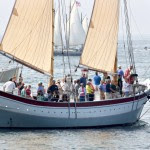 |
| Harold studies the plank line. He is not frozen over, just covered in sawdust and wood chips. |
 |
| Henry S. studies the plank line as well. |
 |
| Zach Teal and Chuck Redman get a look at the plank lines from the stern end. |
 |
| Since this photo was taken, there are now five planks on each side...making headway now! |
 |
| Dan had to get some altitude to take this shot of the interior- yeah photographing from this height is no easy feat! |
 |
| The trunnels are into the frame as the shipwrights fasten another plank. Eventually the trunnels are cut off and a wedge is put in. |
 |
| Here is a good example of what a trunnel looks like on the other side - in this case it is through a frame. |
 |
| The creek between the Essex Shipbuilding Museum and the boatyard is great. Pictured here still embedded in ice is the Pinky Maine on the Burnham side and the Lewis H. Story on the museum side. |



You said "Eventually the trunnels are cut off and a wedge is put in."
ReplyDeleteJust where is the wedge put and if with the trunnel how do you get it started if the trunnel is that tight in the hole to start with ?
Bill Kelleher
When a blind trunnel is driven, its first kerfed and the wedge is insterted just barely into the kerf. As the trunnel bottoms out in the hole, it drives the wedge, splitting the end so that the trunnel will never pull out. Through trunnels are just driven through the pieces to be fastened and then split with a splitting iron and wedged on each end. The trunnels are always split and wedged perpendicular to the grain of the piece they are passing through. - HAB
ReplyDeleteThank you very much for the answer.
ReplyDeleteI now understand how it stays put.
Bill Kelleher